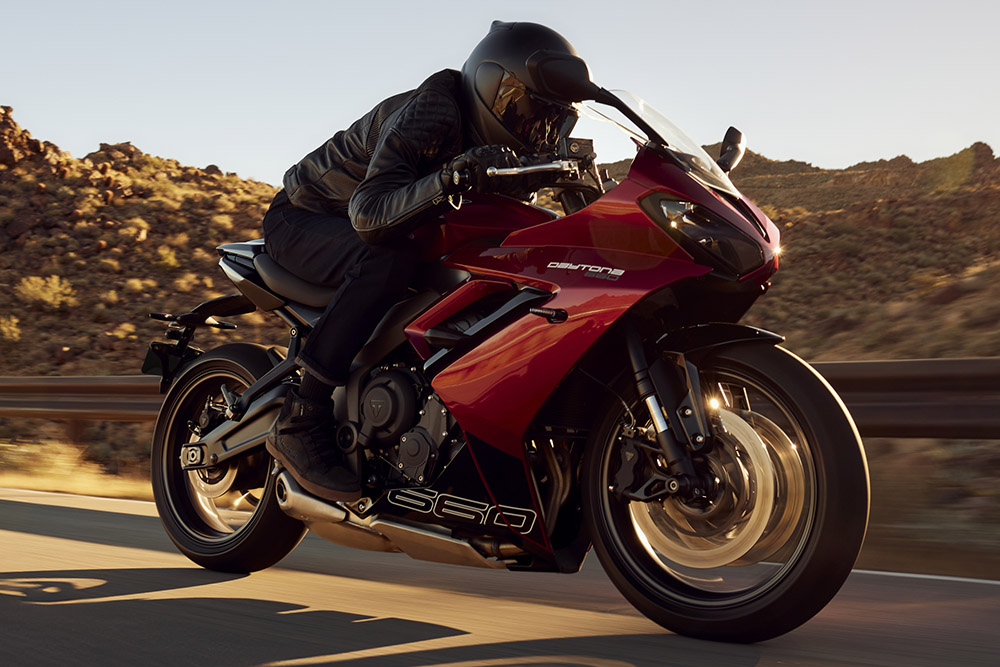The recently announced arrival of the Triumph Daytona 660 sees the return of the famous Daytona nameplate to the Triumph range after an absence of almost five years.
First used in 1967, the Daytona name was initially given to a specced up 500cc twin officially dubbed the T100R Daytona. It paid homage to racer Buddy Elmore and his modified Triumph Tiger 500, who had combined to win the prestigious Daytona 200 race in 1966.
The T100R was based around a modified Tiger chassis and featured twin Amal carburettors, racier camshafts and a revised cylinder head to boost power to a then heady 40bhp. With 500cc being the engine capacity for many racing series, the T100R formed the basis of a race bike, utilised at the Isle of Man TT as well as Daytona – where Gary Nixon made it back-to-back victories for Triumph in 1967.
The T100R remained in Triumph’s range for seven years, disappearing quietly in 1974 but, when the brand was reborn under the stewardship of John Bloor in 1990, the Daytona was one of three name plates used to launch the new range.
Naturally the Daytona was the sportiest of the trio (the Trophy was a tourer and the Trident a standard roadster) and although the initial Daytona 750 and Daytona 1000 weren’t exactly at the cutting edge of the time, they were very solid machines which offered Brit bike fans a sporty motorcycle to be proud of.
Daytona 750/1000 (1991)
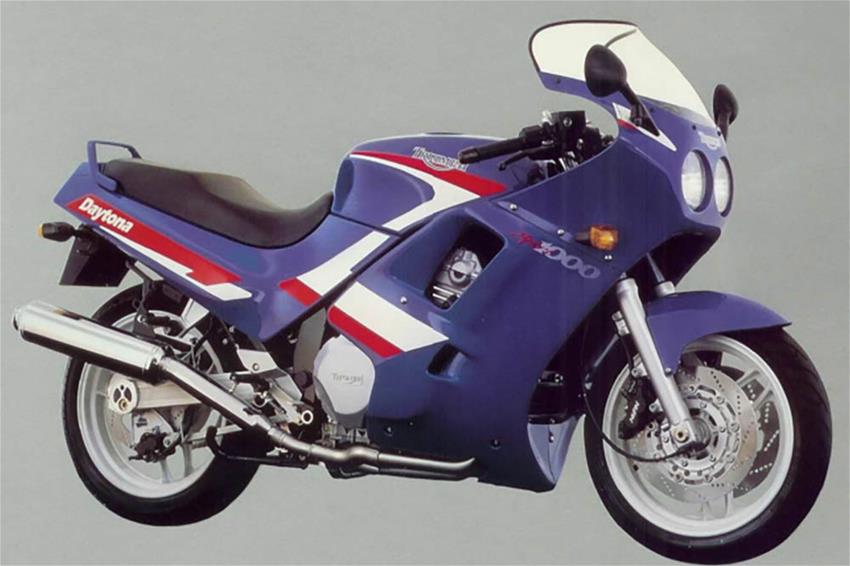
Following the demise of the old Meriden based company in 1983, the rights to the Triumph brand were bought by building magnate John Bloor.
Rather than simply persevere with the ancient twins, Bloor assembled a team to build a completely new range of modern motorcycles from a state-of-the-art factory in Hinckley, Leicestershire.
The revived Triumph offering was unveiled in late 1990, to go on sale the following year. It saw three different models share the same frame, while the engines came in three and four-cylinder configurations with long and short stroke variants for four different capacities.
The Daytona was the sportiest of the trio and used the short stroke motors, creating a 97bhp 750cc triple and a 120bhp 1000cc four.
They were well engineered but big and bulky, owing more to mid-‘80s Japanese designs than the Suzuki GSX-Rs and Yamaha EXUPs which were so popular in 1991. The short stroke motors only stayed in the range for two years, before the Daytona switched to the more popular long stroke engines, the 900 triple and the 1200 four.
Unlike the very first Hinckley Daytonas, which featured Japanese style graphics, these looked distinctive in their smart and subdued colour schemes – especially the popular bright yellow livery. These would set the tone of Triumph’s place in the sportsbike market, offering a more mature and classically British alternative to the more brash Japanese offerings.
Daytona T595/955i (1997)
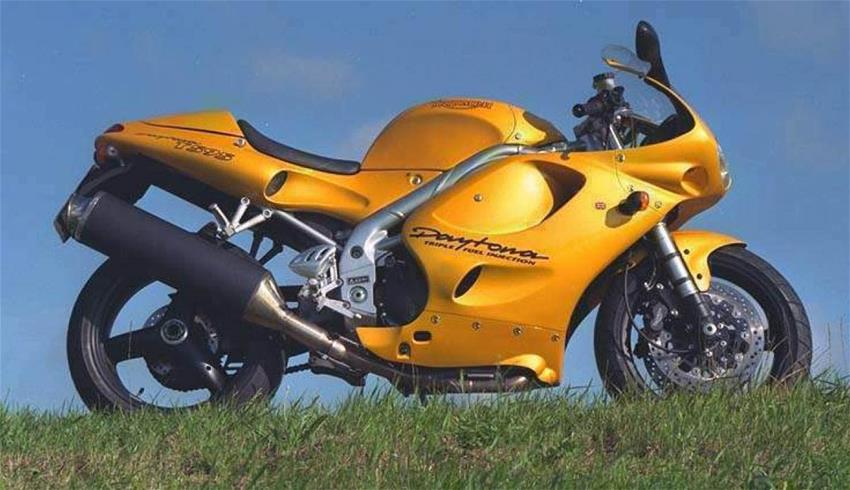
By 1997 Triumph had a reputation as a builder of solidly engineered motorcycles but, a bit like BMW, they were seen as rather old fashioned. The T595 aimed to rectify that and made a step forward. It represents a significant moment in Triumph’s history.
Known originally by its internal development code, T595, the 1997 Daytona diverged from Triumph’s modular production approach. It was a more confident model, and one which debuted much of the design language for which Triumph are renowned even today.
The T595, for example, came only with a three-cylinder engine, while the style of the distinctive frame design would go on to be a common feature on other models.
Where the originals felt like Japanese bikes from a previous generation, the T595 Daytona was more European in its design and not afraid to lead the way with new technologies. For example, at a time when carbs were still the norm, the Lotus developed 130bhp motor was fuel-injected. The single sided swingarm and compact dimensions owed a lot to the iconic Ducati 916 and, although it was a pretty bike, it lacked the outright performance of contemporary sportsbikes like the Ducati 916 and Honda FireBlade. That said, it was always there or thereabouts and had the unique selling points of the three-cylinder engine and more of a GT feeling against the increasingly more extreme superbikes which were emerging in the marketplace.
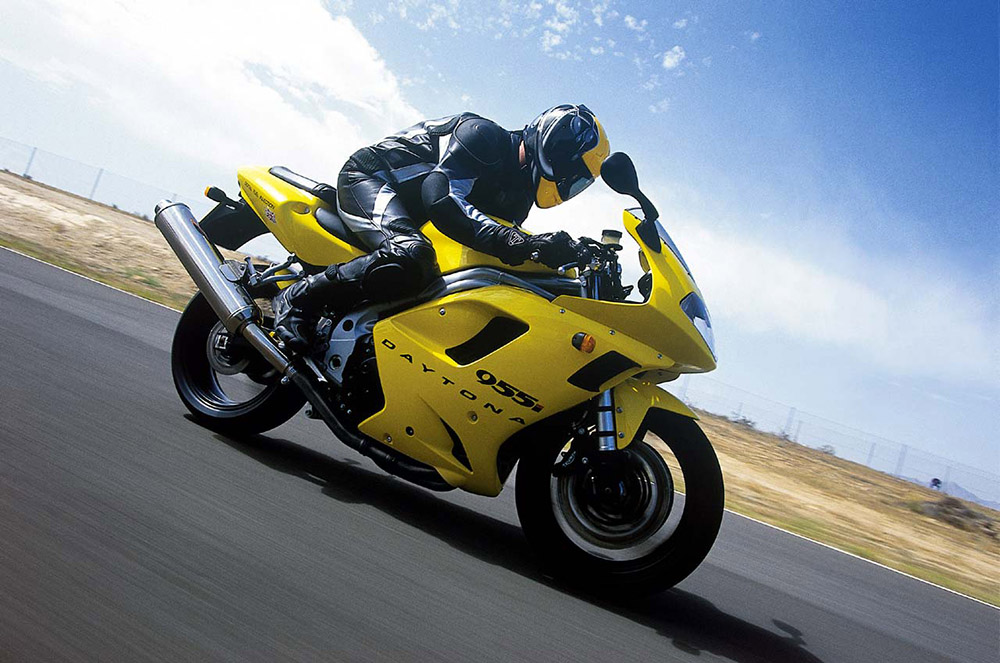
The T595 name lasted just two years, having confused potential buyers who thought it referred to the engine capacity, and it was replaced with a clearer 955i designation on the updated 1999 model. It gained more angular lines and replaced the single sided swingarm with a lighter, conventional, unit while seeing the power upped to 149bhp. But with the Yamaha YZF-R1 arriving in 1998 and completely rewriting the sportsbike rulebook, the Daytona was living on borrowed time. It survived through to the end of 2005, gaining some minor updates and classy colour schemes along the way, but the market had changed and it was not updated when Triumph brought in the 1050cc engine to meet Euro 3 regulations.
Daytona 600 (2002)
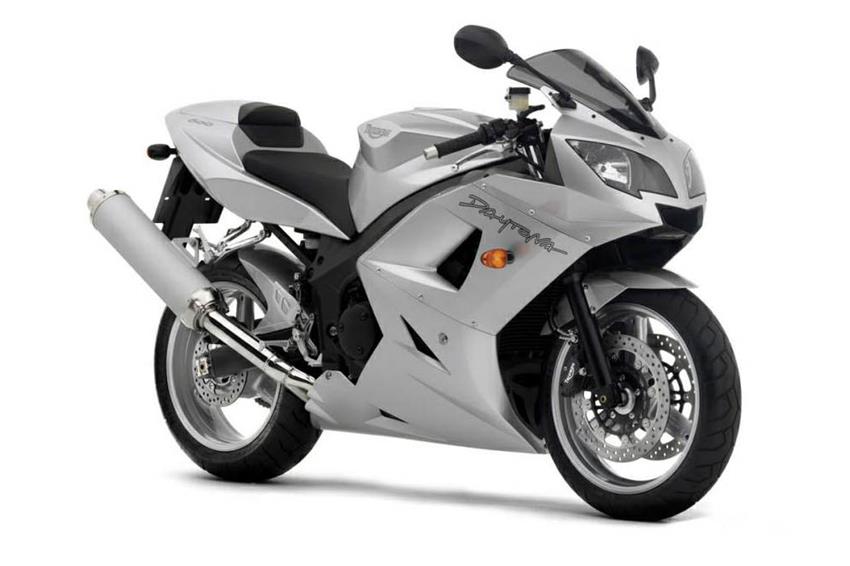
That said, the Daytona bloodline continued uninterrupted and, for a number of years early in the millennium, there were two very different Triumphs wearing the badge.
It was something of a confusing time for Triumph. Having established themselves with the build quality of the first generation models, and making a very credible stab at things with the T595, they made an ill-advised attempt to take on the Japanese head-to-head.
Coming away completely from the modular production approach, the TT600 was Triumph’s bike for the new millennium. It didn’t wear the Daytona name, but it was a sporty model aimed directly at the best-selling Honda CBR600F.
It was a flop and a low point of Triumph product development. It handled well but the fuel injection system was underdeveloped, making it jerky and thoroughly unpleasant to ride. It was also unfortunate to arrive at a time when the Suzuki GSX-R600 and Yamaha YZF-R6 moved the class on to another level. The TT’s jelly mould styling and shell suit graphics made it feel like a Honda CBR600F of the 1990s, and not one of the track inspired 21st century supersport machines riders could not get enough of at the time.
But we mention the TT600 because its replacement was the Daytona 600. Introduced in 2002, underneath the skin was an improved version of the TT600. Overall it was a much better bike, but with Japanese manufacturers constantly introducing new models to compete in this most hotly contested of classes, it was another Daytona which was constantly playing catch up with the competition.
But the Daytona 600 deserves some credit because it got Triumph back to racing. Unlike the Japanese manufacturers, who showcased their products in the white hot competition of World Supersport competition, Triumph’s more modest race programme stayed closer to home, competing in British Supersport and at the Isle of Man TT.
Bruce Anstey gave Triumph its first TT win in 28 years, at the 2003 Junior TT, and exciting young racer Craig Jones won the Daytona 600’s last British Supersport race at the end of 2004. It also scored points at world level, when Jones finished 12th at Silverstone in a one-off race.
The Daytona 600 was discontinued at the end of 2004, when Triumph went down the Kawasaki route of stroking the engine to make the Daytona 650. Like the 955i, the Daytona 650 was a decent sporting road bike. It only lasted a year in production and marked a turning point as Triumph’s last four-cylinder machine.
Daytona 675 (2006)
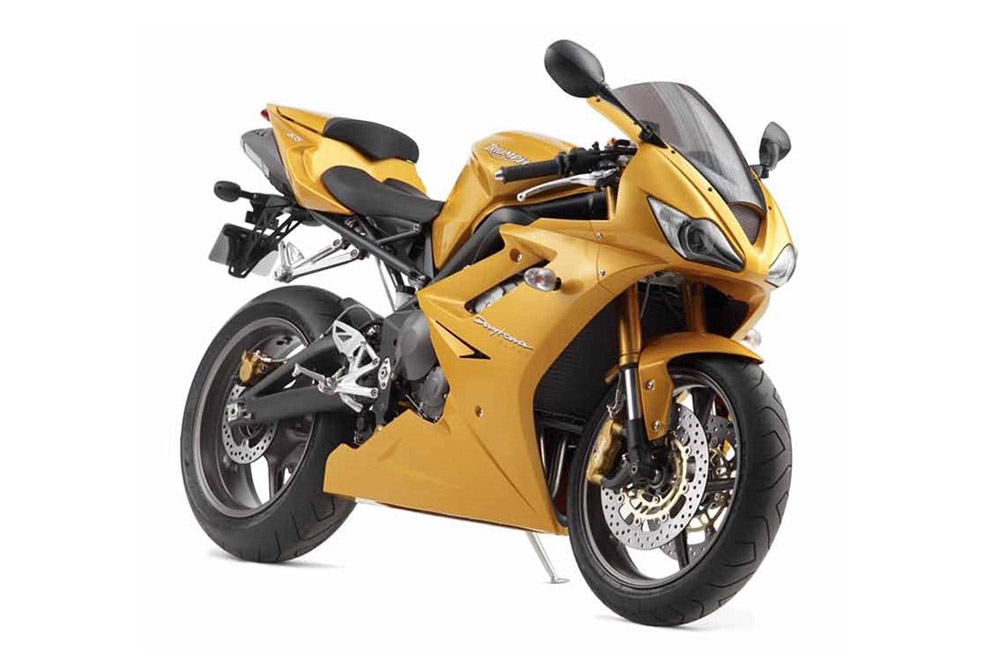
The Daytona 600’s failure contributed to a change of direction for the company and while the 600cc fours were a low point for Triumph, their replacement was a real highlight.
Instead of taking their inspiration from others, the Daytona 675 (or Daytona 675 Triple as it was officially known at launch) was a mid-capacity sportsbike designed without constraint of racing rules or unwritten conventions.
And it was sensational. It was every bit as good on road and track as the established Japanese bikes and was incredibly handsome to boot. It had a soulful engine and, for the first time ever, Hinckley Triumph could claim to build a motorcycle which was world beating.
Although not initially eligible for racing, rules were quickly opened up to allow triples to compete in supersport racing. Once again, Triumph focussed its race programme on the UK and Isle of Man TT – and it won in both. There were some privateer entries in World Supersport racing too, with top riders like Garry McCoy and Chaz Davies scoring podium finishes but failing to get that elusive win.
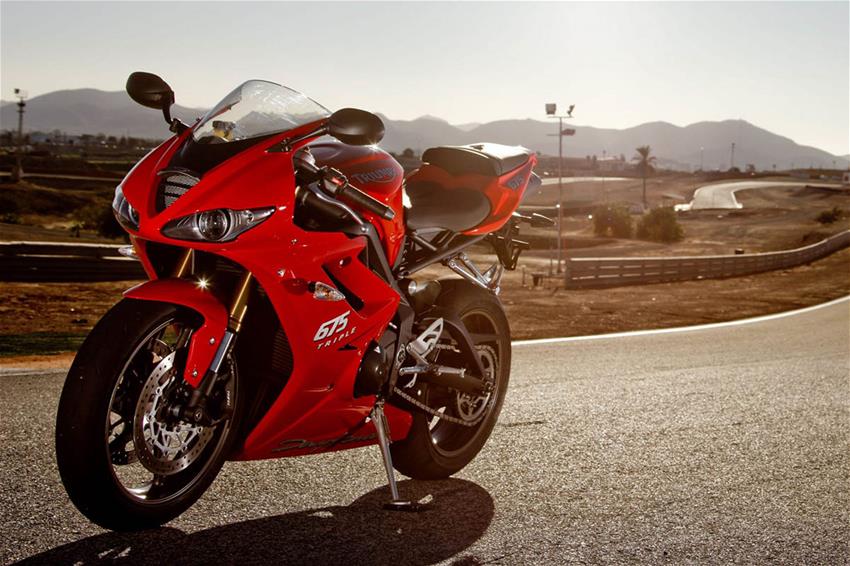
An update came in 2010, tweaking an already winning formula, and the Daytona 675R of 2011 featured fancy suspension from Ohlins, as well as Brembo brakes.
An all-new Daytona 675 arrived in 2013 but, unusually, was not universally considered to be an improvement over its predecessor. The shorter stroke motor was less tractable, while the near collapse of the supersport market saw sales stutter and marked the beginning of the end for the model.
Daytona Moto2 765 (2020)
The Daytona 675 proved something of a stalwart of the Triumph range but was quietly dropped in 2018. New emissions rules meant that updates were required to keep the Daytona on sale but Triumph bosses decided that the tiny demand for supersport machines meant that they were no longer viable. They weren’t the only ones, Honda’s CBR600RR, the Suzuki GSX-R600, Kawasaki ZX-6R and Yamaha YZF-R6 would also disappear from showrooms, either permanently or on hiatus, around this time.
But, around the same time, Triumph was surprisingly announced as the engine supplier for the Moto2 race class, taking over from Honda in 2019 with a powerplant based on the Street Triple 765RS motor.
So, to celebrate, Triumph dropped the 765 engine into the old Daytona chassis for one last hurrah. The 128bhp triple cost £15,765 when it went on sale as a limited run (of 1530 worldwide) but, to justify that big price tag, it had a premium spec including carbon fibre bodywork, Brembo brakes and Ohlins suspension. Sadly, for some, it never led to a permanent, more mass produced model, but it proves a fitting legacy to one of Triumph’s most famous (and now defunct) nameplates.
Daytona 660 (2024)
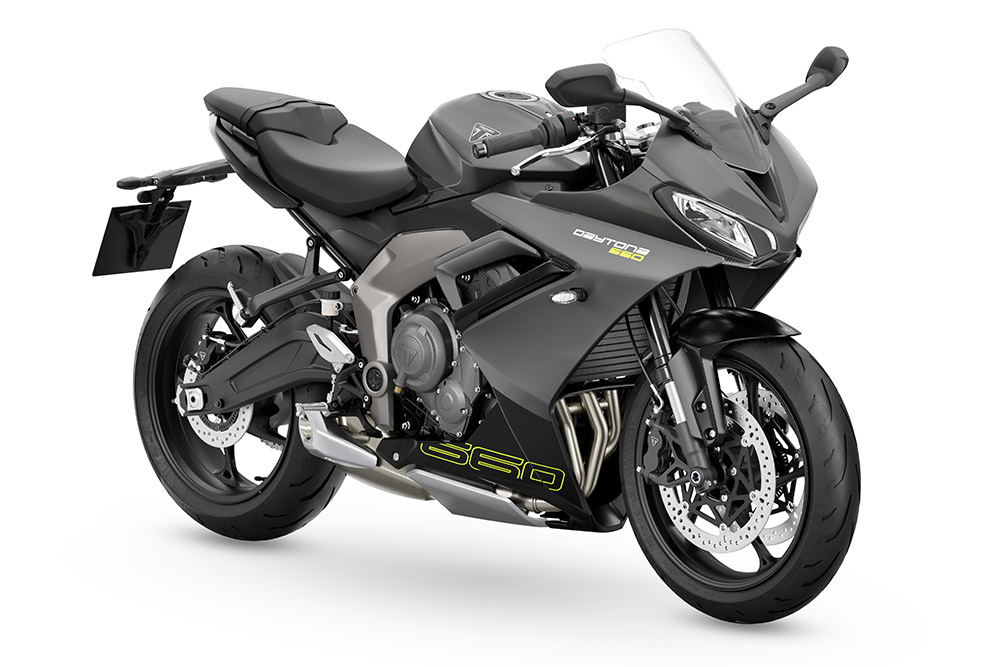
After almost a decade in the doldrums, the mid-capacity sportsbike sector has reinvented itself.
With the old 600s (not to mention Triumph’s 675cc three-cylinder alternative) becoming almost as sophisticated and expensive as 1000cc superbikes, the class had moved away from its roots of providing affordable sportsbikes for the masses and, as a result, had become virtually extinct.
However, a new generation of more affordable bikes are looking to get younger riders back on middleweight sportsters. Bikes like the Kawasaki Ninja 650, Honda CBR650R and Yamaha R7 are less expensive, sub 100bhp motorcycles which are easier to ride and less expensive to buy and run, compared to the supersport machines of the early 2000s.
The Daytona 660 is Triumph’s first entry into the class. It’s based on the popular Trident 660 roadster but heavily modified to offer more performance and greater agility.
The three-cylinder motor pumps out a class leading 94bhp, while the £8595 price tag is hugely competitive. Carrying on the Daytona’s racing tradition, TT ace Peter Hickman has worked with Triumph to develop a race kit for the Daytona 660, allowing it to compete in the new National Sportbike Championship, which will take place alongside the British Superbike Championship races in 2024.
It should be a big success for Triumph when it goes on sale towards the end of March.


